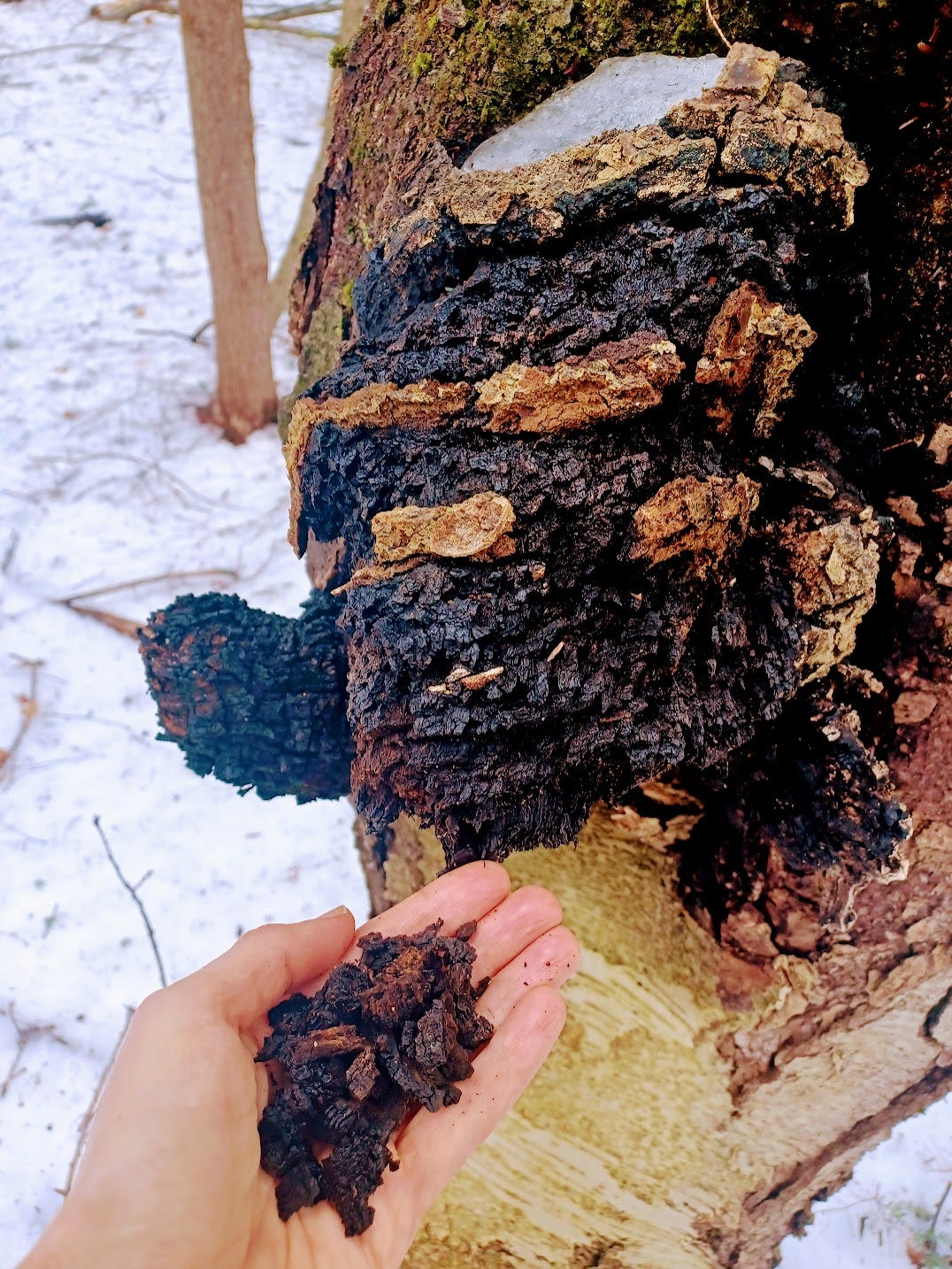Bright rays of sun pierce our sleep and pour into our bed through the skylight. You caress me gently and kiss me wherever you find my star-kissed skin — my back, my forehead, my shoulder. You remind me that these photons, these beams of light that touch me, are incredibly precious, “they have been waiting, bouncing around for roughly 100,000 years inside the core of the sun, waiting, struggling, fighting to reach you.”
I know that all life on Earth is nourished by our committed star. I also know that suns and stars engulf their planets, eventually. Sometimes I think I too will burn up, be consumed in your light. Krishnamurti wrote that “Love can only come into being when there is total self-abandonment” and maybe that’s what love is supposed to do: dissolve the ego; dissolve the self. Like the plant on our windowsill fading from too much attention, life is a delicate dance of nourishment and depletion, growth and retreat.

We make chaga tea when we wake; it has become a morning ritual. The chaga mushrooms were harvested on Mount Owen, land we now steward. A slow growing species, chaga takes 3-5 years to fully form, and because of this, when we gather the mushroom for medicine, we leave plenty on the tree and take only what we need.
Chaga is not the fruiting body of a mushroom, but a medicinal mass of mycelium known as a sclerotia. Unlike most mushrooms, chaga is a polypore, a fungus with pores instead of gills, and rather than growing in soil, chaga prefers birch trees; healing trees that grow quickly on devastated land, creating conditions and habitat for other woodland species to thrive. The rapid life cycle of a birch pushes upward fast causing the tree to fall and break easily. Then, in collaboration with fungi who consume dead wood on the forest floor, the birch rots and creates fertile ground for generations to come.
Some argue that chaga’s relationship with birch tree is parasitic, while others say the relationship is symbiotic, and that chaga helps to heal the tree's wounds. Whatever they go through in their partnership, the combination of the two is potent and chaga, in the most medicinal form, does not exist without their host tree; the predigested betulinic acid derivatives and melano-glucan complexes from birch.
The first time you told me you loved me it was autumn. Days grew darker as we hiked among fiery colors of dying leaves and hunted for mushrooms — maitake, chicken of the woods, turkey tail. You, determined, scanned the edges of trails and found them. I infused our morning coffees, soups and stews with our bounty and as we sipped and ate, we searched for words to share our deepest thoughts, ideas, dreams and desires. We wanted to expose ourselves, to be seen, to offer each other a nakedness beyond our skin.
It was night when you said the words aloud. We were sitting by the fire at your friend's farm. The same place we had our first kiss, the same place you asked to hold my hand. When you said “I love you” that night and when you say it now, the words have weight. They press against me and I breathe deeply so they can sink in. I feel compelled to say it back immediately but really, I want to absorb the words. I want to take their weight inside.
When trees lose branches or suffer damage from storms, the chaga mushroom will grow over the wound to serve as a protective scar. At this point, the cracked mass of chaga, that looks like burnt charcoal, intertwines with the tree to form a unique fungal and tree interaction. The birch tree can continue living for many years while mounds of Chaga adorn her trunk, just as we can survive and even thrive while adorned with scars from old wounds. When chaga is harvested, we find a beautiful color of rust inside.
I imagine chaga must ‘feel’ when the birch tree is injured the way I intuit the needs of those I love, and move to support them when they need to lean on me. Chaga is a mound of protection, a scab around an area of woundedness. But protectiveness itself can become parasitic or smothering, so it's no wonder people debate whether chaga helps or harms the birch.
In love we fall, lose ourselves, forget ourselves and when eventually land on solid ground — with our beloved or without— and the ‘us’ we remember is not quite the same. Psychologist Eric Fromm defined love as a practice. He also said that we expend too much energy on “falling in love” and need to learn more how to “stand in love.” I agree. Though sometimes I feel like I am floating, and then somehow, I descend again. Deeper and deeper. In the beginning, I wanted to remain a perfect projection of what you hoped I would be. But now that we have gone through stress and struggle, I love you more and I feel even more loved. You know now that I am not perfect, not by any means, and you have not abandoned me.
Now it is night. The moonlight touches our skin as our bodies entwine, legs tangled together as one. Every once in a while, I hear you murmur. I kiss you and you tug me closer. In the morning, you make me a breakfast of miso soup filled with all of our leftovers — kale stalks, shiitake mushrooms, carrots, onion, foraged greens; the entire vegetable drawer. You brush my hair as I write and insist on buying detangler for my knotted mane so we shop at the Coop and you roam the aisles with such earnest patience. You read labels and clip coupons. I find it adorable. At night, you ask probing questions about the nature of life, turning things over and over and over in your mind. You say you are proud of me, excited about my writing and work. But still, I get lost in you. We are melding into each other, trying to find our way.
Read more of our love story in my forthcoming book, Earthly Bodies: Embracing Animal Nature.






"They press against me and I breathe deeply so they can sink in. I feel compelled to say it back immediately but really, I want to absorb the words. I want to take their weight inside." - wow I really felt this. Such magnitude and visceral weight of the love here. I felt transported like a ghost or fly on the wall watching the slow beautiful day unfold. Thank you for sharing the beauty of the partnership between Chaga and Birch, allowing us to reflect on how partnerships flow together benefitting each -- and the care needed to maintain a healthy balance of oneness and togetherness.
Beautiful